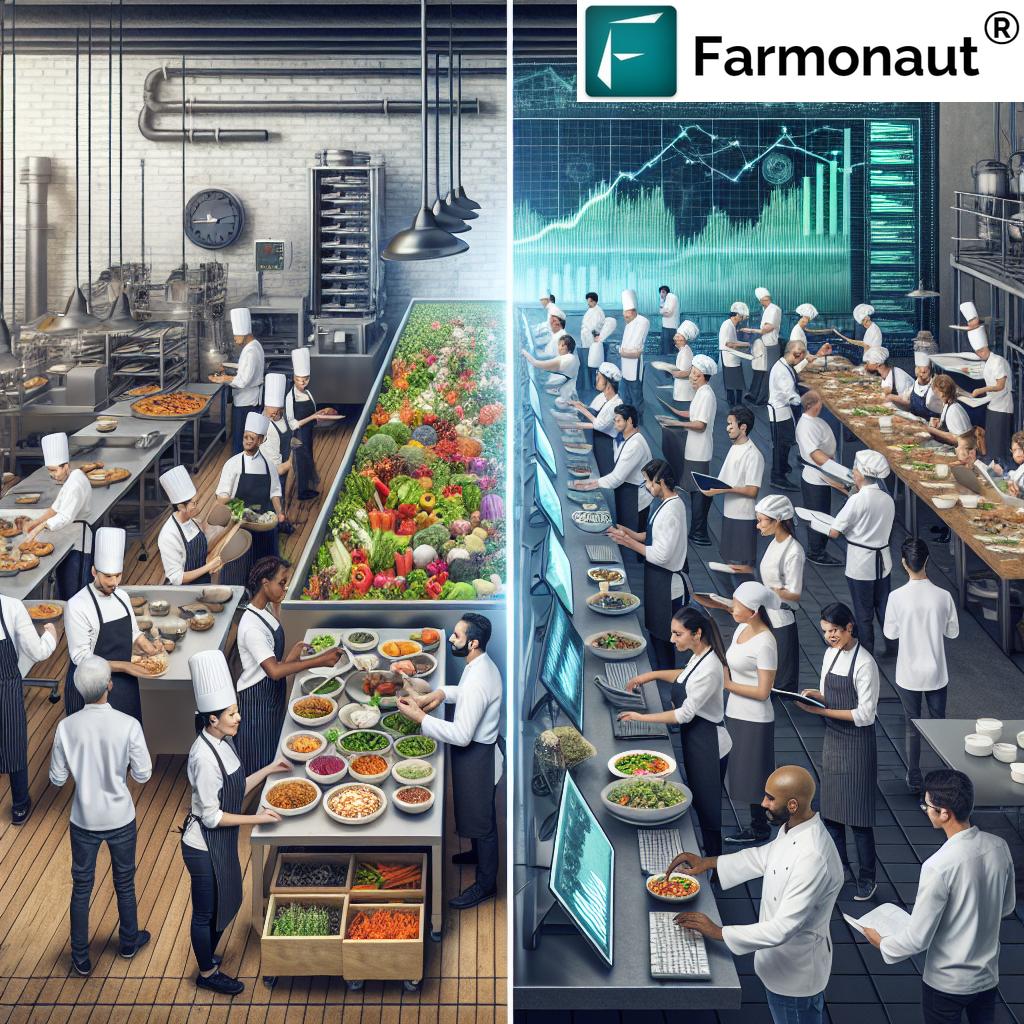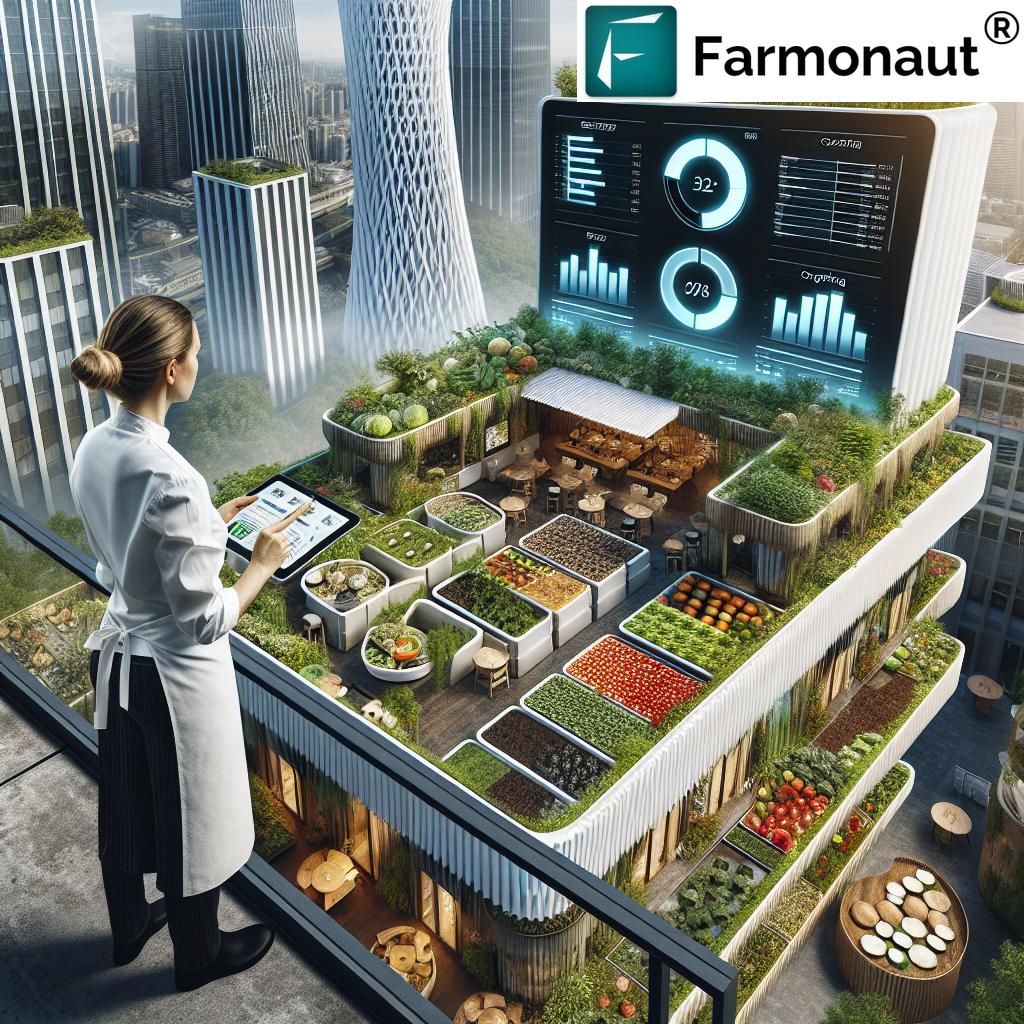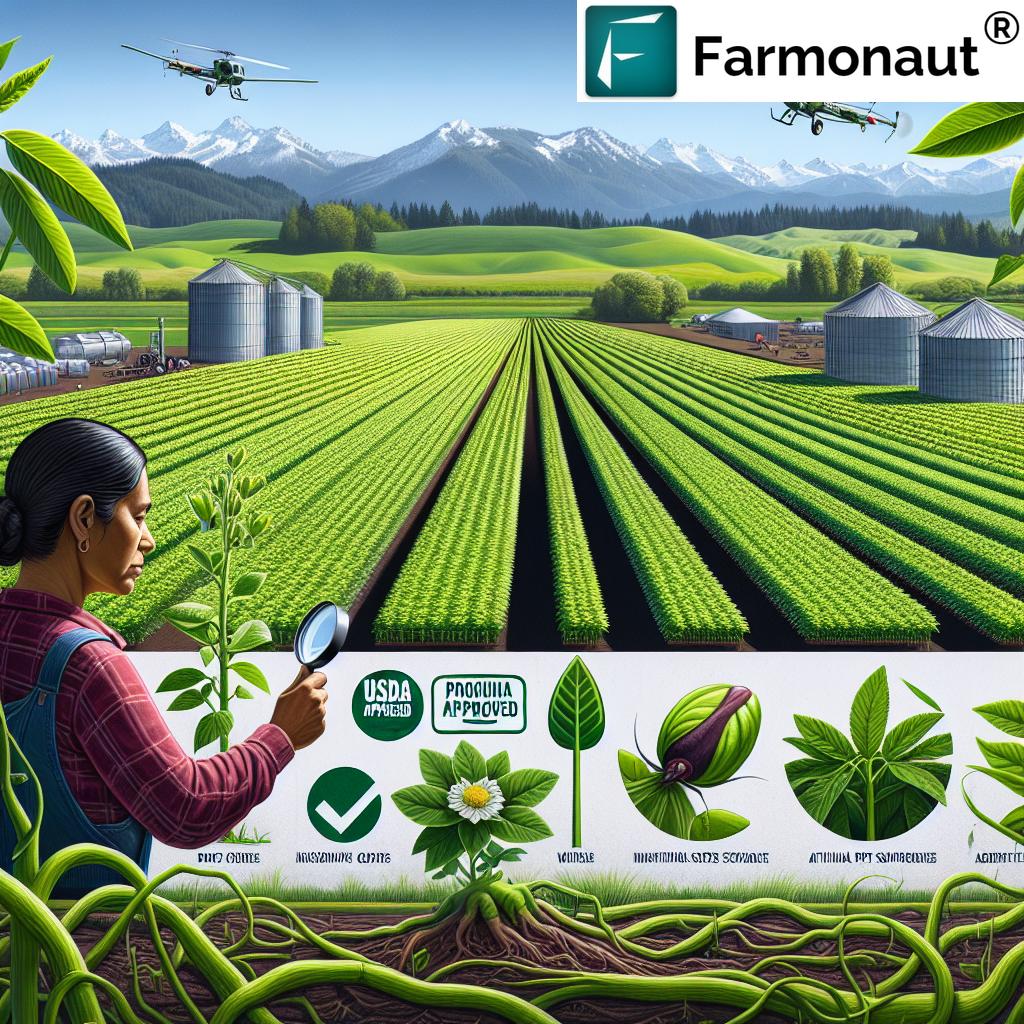Revolutionizing Restaurant Sustainability: How Farmonaut’s AgTech Solutions Slash Food Waste and Boost ROI in America
“Restaurants can earn a $7 return for every $1 invested in food waste reduction strategies.”
In the ever-evolving landscape of the restaurant industry, sustainability has become more than just a buzzword—it’s a necessity. As we delve into the world of food waste reduction and innovative agtech solutions, we’re uncovering groundbreaking strategies that not only benefit the environment but also significantly boost the bottom line for restaurants across America. In this comprehensive guide, we’ll explore how the foodservice sector can lead the charge in reducing food loss, creating a more sustainable future, and revolutionizing restaurant management practices.
The Food Waste Challenge in American Restaurants
Food waste is a pervasive issue in the United States, with restaurants being significant contributors. According to recent studies, the US foodservice industry generates millions of tons of food waste annually. This not only represents a substantial economic loss but also has severe environmental implications. As sustainability becomes increasingly important to consumers and businesses alike, addressing this challenge has become a top priority for the restaurant sector.

The Financial Incentive: A $7 Return on Every Dollar Invested
One of the most compelling reasons for restaurants to invest in food waste reduction is the remarkable return on investment (ROI). A groundbreaking study has revealed that for every dollar invested in combating food waste, restaurants can earn an astounding $7 in return. This significant ROI not only makes sustainability initiatives financially viable but also highly profitable.
Let’s break down how this ROI translates into real-world benefits for restaurants:
- Reduced Food Costs: By implementing effective waste reduction strategies, restaurants can significantly lower their food purchasing costs.
- Improved Inventory Management: Better tracking and utilization of ingredients lead to less spoilage and more efficient use of resources.
- Enhanced Customer Perception: Sustainability efforts can boost a restaurant’s reputation, potentially increasing customer loyalty and attracting new patrons.
- Operational Efficiency: Streamlined processes for handling food waste can lead to overall improvements in kitchen operations.
The “Target, Measure, Act” Framework: A Proven Approach
“Implementing the ‘target, measure, act’ framework helps restaurants reduce food waste by an average of 26%.”
One of the most effective strategies for tackling food waste in restaurants is the “target, measure, act” framework. This systematic approach has helped diverse establishments reduce food waste by an impressive average of 26%. Here’s how it works:
- Target: Identify specific areas where food waste is most prevalent in your restaurant.
- Measure: Implement systems to accurately track and quantify food waste in these targeted areas.
- Act: Develop and execute strategies to reduce waste based on the data collected.
This framework’s success lies in its data-driven approach, allowing restaurants to make informed decisions and implement targeted solutions. By consistently applying this method, restaurants can achieve substantial reductions in food waste over time.
Innovative AgTech Solutions for Food Waste Reduction
In the quest to slash food waste and boost ROI, restaurants are turning to cutting-edge agtech solutions. These technologies are revolutionizing how restaurants manage their food inventory, track waste, and optimize their operations. Let’s explore some of the most promising agtech innovations making waves in the industry:
1. AI-Powered Inventory Management Systems
Artificial Intelligence (AI) is transforming inventory management in restaurants. These systems use machine learning algorithms to predict demand, optimize ordering, and reduce overstock situations. By analyzing historical data, seasonal trends, and even local events, AI can help restaurants maintain just the right amount of inventory, significantly reducing the likelihood of food spoilage.
2. IoT-Enabled Smart Kitchen Equipment
Internet of Things (IoT) devices are making kitchens smarter and more efficient. Smart refrigerators can monitor temperature and humidity levels, alerting staff to potential issues before food spoils. Connected scales can automatically track food waste, providing real-time data on what’s being thrown away and why. This granular level of insight allows restaurants to make data-driven decisions to reduce waste.
3. Blockchain for Supply Chain Transparency
Blockchain technology is enhancing traceability and transparency in the food supply chain. By implementing blockchain solutions, restaurants can track their ingredients from farm to table, ensuring freshness and reducing the likelihood of overordering or receiving subpar products. This technology also enables restaurants to verify the sustainability claims of their suppliers, aligning with consumer demands for environmentally responsible sourcing.
4. Data Analytics for Menu Optimization
Advanced data analytics tools are helping restaurants optimize their menus to reduce waste. By analyzing sales data, customer preferences, and ingredient usage patterns, these tools can suggest menu changes that minimize waste while maximizing profitability. This might include recommendations for cross-utilizing ingredients, adjusting portion sizes, or introducing new dishes that align with current inventory levels.
5. Mobile Apps for Food Donation and Redistribution
Innovative mobile applications are connecting restaurants with local food banks and charities, making it easier to donate excess food safely and efficiently. These apps streamline the donation process, ensuring that surplus food reaches those in need instead of ending up in landfills. Not only does this reduce waste, but it also strengthens community relations and can provide tax benefits for restaurants.
Farmonaut’s Contribution to Restaurant Sustainability
In the realm of agtech solutions for food waste reduction, Farmonaut stands out as a pioneering force. While primarily known for its advanced satellite-based farm management solutions, Farmonaut’s technologies have significant implications for the restaurant industry’s sustainability efforts.
Here’s how Farmonaut’s innovative solutions can benefit restaurants in their quest to reduce food waste and boost ROI:
- Supply Chain Optimization: Farmonaut’s satellite-based crop health monitoring can help restaurants partner with farmers to ensure a steady supply of fresh, high-quality produce. This can lead to reduced waste from spoilage and improved ingredient quality.
- Blockchain-Based Traceability: Farmonaut’s blockchain solutions enable restaurants to track their ingredients from farm to table, ensuring transparency and reducing waste due to quality issues or overordering.
- AI-Driven Insights: The Jeevn AI Advisory System can be adapted to provide restaurants with valuable insights on crop yields and availability, helping them make informed decisions about menu planning and ingredient sourcing.
- Carbon Footprint Tracking: Farmonaut’s carbon footprinting technology can help restaurants monitor and reduce their environmental impact, aligning with consumer demands for sustainable dining options.
Restaurants interested in leveraging Farmonaut’s technologies can explore their offerings through various platforms:



For developers and businesses looking to integrate Farmonaut’s data into their own systems, the company offers API access:
Implementing Sustainable Restaurant Management Practices
While technology plays a crucial role in reducing food waste, implementing sustainable management practices is equally important. Here are some key strategies that restaurants can adopt to enhance their sustainability efforts:
1. Staff Training and Engagement
Educating staff about the importance of food waste reduction and involving them in sustainability initiatives is crucial. This can include:
- Regular training sessions on proper food handling and storage techniques
- Encouraging staff to suggest waste reduction ideas
- Implementing incentive programs for meeting waste reduction targets
2. Portion Control and Flexible Menu Options
Offering varied portion sizes and flexible menu options can significantly reduce plate waste. Consider:
- Introducing smaller portion options at reduced prices
- Allowing customers to customize their meals
- Offering “half-portions” of certain dishes
3. Nose-to-Tail and Root-to-Stem Cooking
Embracing these culinary philosophies can maximize ingredient usage and reduce waste:
- Utilizing less common cuts of meat in creative dishes
- Incorporating vegetable stems, leaves, and peels into recipes
- Creating stocks and broths from leftover ingredients
4. Composting and Recycling Programs
Implementing robust composting and recycling programs can divert a significant amount of waste from landfills:
- Setting up separate bins for compostable food waste
- Partnering with local composting facilities or farms
- Ensuring proper recycling of packaging materials
5. Sustainable Sourcing Practices
Choosing suppliers who prioritize sustainability can have a ripple effect on reducing waste throughout the supply chain:
- Partnering with local farmers for fresher, seasonal produce
- Selecting suppliers with sustainable packaging practices
- Prioritizing suppliers who use regenerative agriculture techniques

Measuring the Impact: Key Performance Indicators for Food Waste Reduction
To effectively reduce food waste, restaurants need to establish clear metrics and regularly monitor their progress. Here are some essential Key Performance Indicators (KPIs) to track:
- Total Food Waste by Weight: Measure the total amount of food waste generated daily or weekly.
- Food Waste as a Percentage of Food Purchased: Calculate the ratio of food waste to total food purchased.
- Waste by Category: Break down waste into categories (e.g., prep waste, spoilage, plate waste) to identify specific areas for improvement.
- Cost of Food Waste: Quantify the financial impact of food waste on your business.
- Waste Reduction Over Time: Track the percentage reduction in food waste compared to your baseline.
Regularly reviewing these KPIs can help restaurants identify trends, measure the effectiveness of their waste reduction strategies, and make data-driven decisions for continuous improvement.
Creative Food Waste Recycling Methods
Beyond traditional composting, innovative restaurants are finding creative ways to recycle and repurpose food waste, turning it into new revenue streams or valuable resources:
1. Upcycled Food Products
Some restaurants are creating new products from what would typically be considered waste:
- Turning citrus peels into candied garnishes or flavored salts
- Creating flour from spent grains (popular in brewpubs)
- Developing house-made vinegars from fruit scraps
2. Biogas Production
Larger restaurant chains or clusters of restaurants can invest in biogas digesters to convert food waste into energy:
- Using biogas to power kitchen equipment or heat water
- Selling excess energy back to the grid
3. Animal Feed
Partnering with local farms to use food scraps as animal feed can be a win-win solution:
- Providing nutritious feed for livestock
- Reducing waste disposal costs for restaurants
4. Artisanal Crafts
Some restaurants are getting creative with non-food applications of waste:
- Using coffee grounds to create exfoliating soaps
- Crafting decorative items from oyster shells
Influencing Consumer Behavior Towards Sustainability
Restaurants have a unique opportunity to educate and influence consumer behavior regarding food waste and sustainability. Here are some strategies to engage customers in your sustainability efforts:
1. Transparent Communication
- Share your sustainability goals and progress with customers through menu inserts, table tents, or digital displays
- Use social media to highlight your waste reduction initiatives and their impact
2. Interactive Education
- Offer “zero-waste cooking” classes or demonstrations to customers
- Create engaging infographics about food waste and sustainability to display in your restaurant
3. Incentivize Sustainable Choices
- Offer discounts for customers who bring their own takeout containers
- Implement a loyalty program that rewards sustainable choices
4. Collaborate with Local Schools and Community Organizations
- Host field trips to showcase your sustainable kitchen practices
- Participate in community events focused on sustainability and food waste reduction
ROI Comparison of Food Waste Reduction Strategies
To help restaurants make informed decisions about which food waste reduction strategies to implement, we’ve compiled a table comparing the ROI of various approaches:
| Strategy Name | Implementation Cost | Estimated Food Waste Reduction (%) | Estimated Annual Savings ($) | ROI (%) |
|---|---|---|---|---|
| Inventory Management System | High | 20-30% | 50,000 – 100,000 | 200-400% |
| Staff Training on Portion Control | Low | 10-15% | 10,000 – 30,000 | 500-1500% |
| Food Donation Program | Medium | 5-10% | 5,000 – 15,000 | 100-300% |
| Composting System | Medium | 15-25% | 20,000 – 40,000 | 150-300% |
| Menu Optimization | Low | 10-20% | 15,000 – 35,000 | 600-1400% |
Note: These figures are estimates and can vary based on the size and type of restaurant, as well as local market conditions.
The Global Perspective: Food Waste Reduction in Different Regions
While our focus has been on restaurants in America, it’s important to understand that food waste is a global issue. Different regions around the world are tackling this challenge in unique ways, often influenced by local culture, regulations, and available technologies. Let’s take a brief look at how other parts of the world are addressing food waste in the restaurant industry:
Europe
- Many European countries have implemented strict regulations on food waste disposal
- The EU has set targets to halve per capita food waste at the retail and consumer level by 2030
- Some countries, like France, have laws requiring large restaurants to donate unsold food
Asia
- In Japan, the “mottainai” culture promotes using every part of an ingredient
- South Korea has implemented a pay-as-you-throw system for food waste
- Singapore is investing heavily in food waste recycling technologies
Australia
- The country has set a goal to halve food waste by 2030
- Many restaurants are partnering with food rescue organizations
- There’s a growing trend of “zero-waste” restaurants
Africa
- Focus on improving cold chain logistics to reduce spoilage
- Increasing use of mobile apps to connect restaurants with food banks
- Growing awareness of traditional preservation techniques
Middle East
- Initiatives to reduce food waste during large-scale events and buffets
- Increasing adoption of AI and IoT technologies in restaurant kitchens
- Growing trend of farm-to-table restaurants to minimize supply chain waste
By learning from global best practices, restaurants in America can adopt and adapt innovative strategies from around the world to enhance their own food waste reduction efforts.
The Future of Food Waste Reduction in Restaurants
As we look to the future, several emerging trends and technologies are set to further revolutionize food waste reduction in the restaurant industry:
1. Artificial Intelligence and Machine Learning
AI and ML will play an increasingly significant role in predicting customer demand, optimizing inventory, and even suggesting menu changes based on available ingredients and historical data.
2. Augmented Reality in Kitchen Management
AR technologies could help kitchen staff visualize portion sizes, optimal ingredient usage, and even provide real-time guidance on reducing waste during food preparation.
3. Advanced Food Preservation Technologies
Innovations in food preservation, such as edible coatings and nanotechnology-based packaging, will help extend the shelf life of ingredients and reduce spoilage.
4. Vertical Farming Integration
More restaurants may integrate vertical farming systems directly into their establishments, ensuring a constant supply of fresh produce with minimal transportation waste.
5. Blockchain for End-to-End Traceability
Blockchain technology will enable complete transparency in the food supply chain, allowing restaurants to make more informed decisions about sourcing and reducing waste at every step.
Conclusion: A Call to Action for Sustainable Dining
As we’ve explored throughout this comprehensive guide, reducing food waste in restaurants is not just an environmental imperative—it’s a significant opportunity for financial growth and innovation. With the potential to earn a $7 return on every dollar invested in food waste reduction strategies, restaurants have a compelling reason to embrace sustainability.
From implementing cutting-edge agtech solutions to adopting proven management practices, there are numerous ways for restaurants of all sizes to make a positive impact. By leveraging technologies like those offered by Farmonaut, restaurants can gain valuable insights into their supply chain, optimize their operations, and contribute to a more sustainable food system.
As consumers become increasingly aware of the environmental impact of their dining choices, restaurants that prioritize sustainability will not only reduce costs but also attract a loyal customer base. The future of the restaurant industry is undoubtedly green, and those who lead the charge in food waste reduction will be well-positioned for long-term success.
We encourage all restaurateurs, chefs, and food service professionals to take action today. Start by implementing the “target, measure, act” framework, explore innovative technologies, and engage your staff and customers in your sustainability journey. Together, we can revolutionize the restaurant industry, slash food waste, boost ROI, and create a more sustainable future for all.
FAQs
-
Q: What is the average ROI for implementing food waste reduction strategies in restaurants?
A: According to recent studies, restaurants can expect to earn a $7 return for every $1 invested in food waste reduction strategies, representing a 700% ROI.
-
Q: How much can the “target, measure, act” framework reduce food waste in restaurants?
A: On average, restaurants implementing the “target, measure, act” framework have seen a 26% reduction in food waste.
-
Q: What are some low-cost strategies for reducing food waste in small restaurants?
A: Small restaurants can start with staff training on portion control, implementing a first-in-first-out (FIFO) inventory system, and partnering with local food banks for donations.
-
Q: How can technology help restaurants reduce food waste?
A: Technologies like AI-powered inventory management systems, IoT-enabled smart kitchen equipment, and blockchain for supply chain transparency can significantly help restaurants reduce food waste.
-
Q: What role do consumers play in reducing restaurant food waste?
A: Consumers can contribute by being mindful of portion sizes, asking for doggy bags for leftovers, and supporting restaurants that prioritize sustainability and waste reduction efforts.
Farmonaut Subscriptions

















